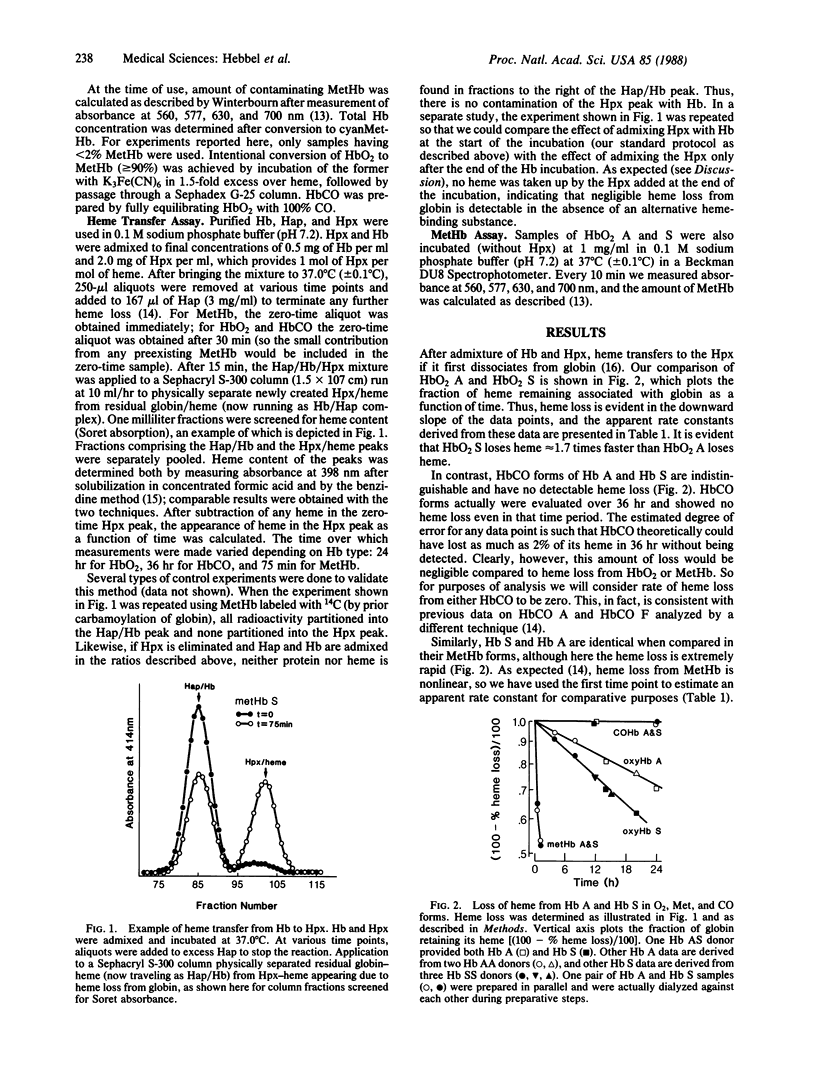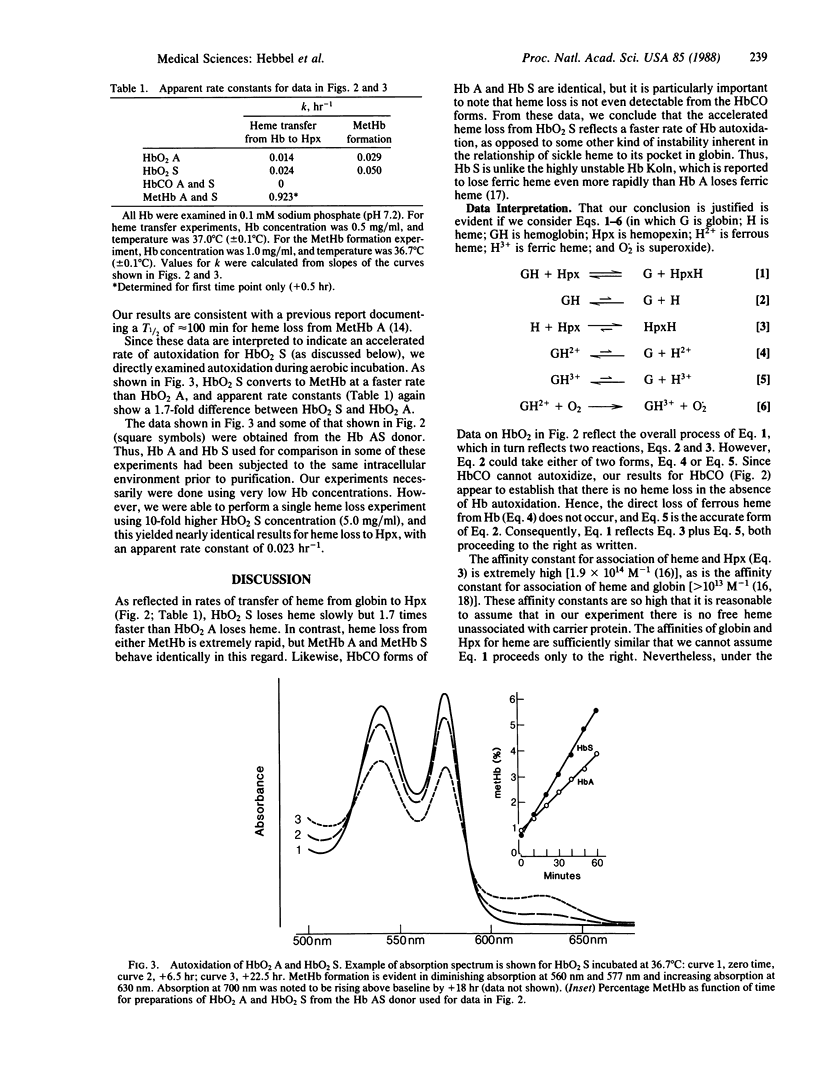Abstract
The pleiotropic effect of the sickle gene suggests that factors in addition to polymerization of the mutant gene product might be involved in sickle disease pathobiology. We have examined rates of heme transfer to hemopexin from hemoglobin in dilute aqueous solution (0.5 mg of Hb per ml) at 37 degrees C. HbO2 S loses heme 1.7 times faster than HbO2 A, with apparent rate constants of 0.024 hr-1 and 0.014 hr-1, respectively. In contrast, Hb A and Hb S behave identically in their MetHb forms (very rapid heme loss) and their HbCO forms (zero heme loss). This indicates that the faster heme loss from HbO2 S is due to accelerated autoxidation (HbO2----MetHb) rather than to some other type of instability inherent in the relationship of sickle heme to its pocket in globin. This interpretation is supported by spectrophotometric measurement of initial rates of MetHb formation during incubation at 37 degrees C. This directly shows 1.7 times faster autoxidation, with apparent rate constants of 0.050 hr-1 for HbO2 S and 0.029 hr-1 for HbO2 A. While the participation of this process in the cellular pathobiology of sickle erythrocytes remains unproven, the present data are consistent with, and perhaps help explain, two prior observations: the excessive spontaneous generation of superoxide by sickle erythrocytes; and the abnormal deposition of heme and heme proteins on membranes of sickle erythrocytes.
Full text
PDF




Selected References
These references are in PubMed. This may not be the complete list of references from this article.
- Asakura T., Minakata K., Adachi K., Russell M. O., Schwartz E. Denatured hemoglobin in sickle erythrocytes. J Clin Invest. 1977 Apr;59(4):633–640. doi: 10.1172/JCI108681. [DOI] [PMC free article] [PubMed] [Google Scholar]
- Asakura T., Onishi T., Friedman S., Schwartz E. Abnormal precipitation of oxyhemoglobin S by mechanical shaking. Proc Natl Acad Sci U S A. 1974 May;71(5):1594–1598. doi: 10.1073/pnas.71.5.1594. [DOI] [PMC free article] [PubMed] [Google Scholar]
- BANERJEE R. [Thermodynamic study of the heme-globin association. II. Methemoglobin]. Biochim Biophys Acta. 1962 Oct 22;64:385–395. doi: 10.1016/0006-3002(62)90747-3. [DOI] [PubMed] [Google Scholar]
- Bauminger E. R., Cohen S. G., Ofer S., Rachmilewitz E. A. Quantitative studies of ferritinlike iron in erythrocytes of thalassemia, sickle-cell anemia, and hemoglobin Hammersmith with Mössbauer spectroscopy. Proc Natl Acad Sci U S A. 1979 Feb;76(2):939–943. doi: 10.1073/pnas.76.2.939. [DOI] [PMC free article] [PubMed] [Google Scholar]
- Bookchin R. M., Lew V. L. Red cell membrane abnormalities in sickle cell anemia. Prog Hematol. 1983;13:1–23. [PubMed] [Google Scholar]
- Bunn H. F., Jandl J. H. Exchange of heme among hemoglobins and between hemoglobin and albumin. J Biol Chem. 1968 Feb 10;243(3):465–475. [PubMed] [Google Scholar]
- CROSBY W. H., FURTH F. W. A modification of the benzidine method for measurement of hemoglobin in plasma and urine. Blood. 1956 Apr;11(4):380–383. [PubMed] [Google Scholar]
- Delers F., Lombart C., Domingo M., Musquera S. A novel and specific method for the purification of hemoglobin-binding proteins. Anal Biochem. 1981 Dec;118(2):353–357. doi: 10.1016/0003-2697(81)90593-5. [DOI] [PubMed] [Google Scholar]
- Eaton J. W., Brandt P., Mahoney J. R., Lee J. T., Jr Haptoglobin: a natural bacteriostat. Science. 1982 Feb 5;215(4533):691–693. doi: 10.1126/science.7036344. [DOI] [PubMed] [Google Scholar]
- Hebbel R. P., Eaton J. W., Balasingam M., Steinberg M. H. Spontaneous oxygen radical generation by sickle erythrocytes. J Clin Invest. 1982 Dec;70(6):1253–1259. doi: 10.1172/JCI110724. [DOI] [PMC free article] [PubMed] [Google Scholar]
- Hrkal Z., Muller-Eberhard U. Partial characterization of the heme-binding serum glycoproteins rabbit and human hemopexin. Biochemistry. 1971 May 11;10(10):1746–1750. doi: 10.1021/bi00786a002. [DOI] [PubMed] [Google Scholar]
- Hrkal Z., Vodrázka Z., Kalousek I. Transfer of heme from ferrihemoglobin and ferrihemoglobin isolated chains to hemopexin. Eur J Biochem. 1974 Mar 15;43(1):73–78. doi: 10.1111/j.1432-1033.1974.tb03386.x. [DOI] [PubMed] [Google Scholar]
- Ip S. H., Ackers G. K. Thermodynamic studies on subunit assembly in human hemoglobin. Temperature dependence of the dimer-tetramer association constants for oxygenated and unliganded hemoglobins. J Biol Chem. 1977 Jan 10;252(1):82–87. [PubMed] [Google Scholar]
- Jacob H. S., Brain M. C., Dacie J. V., Carrell R. W., Lehmann H. Abnormal haem binding and globin SH group blockade in unstable haemoglobins. Nature. 1968 Jun 29;218(5148):1214–1217. doi: 10.1038/2181214a0. [DOI] [PubMed] [Google Scholar]
- Lynch R. E., Lee R., Cartwright G. E. Inhibition by superoxide dismutase of methemoglobin formation from oxyhemoglobin. J Biol Chem. 1976 Feb 25;251(4):1015–1019. [PubMed] [Google Scholar]
- MacDonald V. W., Charache S. Drug-induced oxidation and precipitation of hemoglobins A, S and C. Biochim Biophys Acta. 1982 Feb 4;701(1):39–44. doi: 10.1016/0167-4838(82)90309-0. [DOI] [PubMed] [Google Scholar]
- Mansouri A., Winterhalter K. H. Nonequivalence of chains in hemoglobin oxidation and oxygen binding. Effect of organic phosphates. Biochemistry. 1974 Jul 30;13(16):3311–3314. doi: 10.1021/bi00713a021. [DOI] [PubMed] [Google Scholar]
- Mansouri A., Winterhalter K. H. Nonequivalence of chains in hemoglobin oxidation. Biochemistry. 1973 Nov 20;12(24):4946–4949. doi: 10.1021/bi00748a020. [DOI] [PubMed] [Google Scholar]
- Morgan W. T., Smith A. Domain structure of rabbit hemopexin. Isolation and characterization of a heme-binding glycopeptide. J Biol Chem. 1984 Oct 10;259(19):12001–12006. [PubMed] [Google Scholar]
- Rachmilewitz E. A. Denaturation of the normal and abnormal hemoglobin molecule. Semin Hematol. 1974 Oct;11(4):441–462. [PubMed] [Google Scholar]
- Schaeffer K., Lofton J. A., Powell S. C., Osborne H. H., Foster L. H. Occurrence of copper in sickling erythrocytes. Proc Soc Exp Biol Med. 1968 Jul;128(3):734–737. doi: 10.3181/00379727-128-33112. [DOI] [PubMed] [Google Scholar]
- Vretblad P., Hjorth R. The use of wheat-germ lectin-Sepharose for the purification of human haemopexin. Biochem J. 1977 Dec 1;167(3):759–764. doi: 10.1042/bj1670759. [DOI] [PMC free article] [PubMed] [Google Scholar]
- Wallace W. J., Houtchens R. A., Maxwell J. C., Caughey W. S. Mechanism of autooxidation for hemoglobins and myoglobins. Promotion of superoxide production by protons and anions. J Biol Chem. 1982 May 10;257(9):4966–4977. [PubMed] [Google Scholar]
- Watkins J. A., Kawanishi S., Caughey W. S. Autoxidation reactions of hemoglobin A free from other red cell components: a minimal mechanism. Biochem Biophys Res Commun. 1985 Oct 30;132(2):742–748. doi: 10.1016/0006-291x(85)91195-7. [DOI] [PubMed] [Google Scholar]


